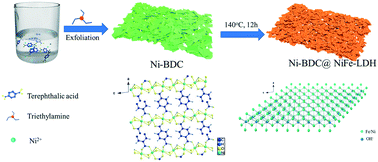The in situ derivation of a NiFe-LDH ultra-thin layer on Ni-BDC nanosheets as a boosted electrocatalyst for the oxygen evolution reaction†
Abstract
A Ni-based metal organic framework (Ni-BDC) and subsequently derived NiFe-LDH were studied to overcome the defect of the low availability of active sites for the oxygen evolution reaction (OER) during the water splitting process. This work reported NiFe-LDH nanosheets with an ultra-thin structure through an in situ surface-conversion derived from Ni-BDC. The unique structure and characteristic morphology were confirmed using X-ray diffraction, X-ray photoelectron spectroscopy, scanning electron microscopy, and transmission electron microscopy, and the OER activities of the catalysts were systematically studied. The obtained results indicated that the synthesized Ni-BDC@NiFe-LDH-2 showed excellent OER activity, with a low overpotential of 272 mV at a current density of 10 mA cm−2, a small Tafel slope of 45 mV dec−1, and excellent stability, owing to the addition of abundant metal sites and the expansion of the electron transport channels during the conversion process to form the ultra-thin layer structure. This work provides a novel strategy for the application, design, and manufacture of metal organic framework (MOF)-based high-efficiency active materials.

- This article is part of the themed collection: Nanomaterials


 Please wait while we load your content...
Please wait while we load your content...